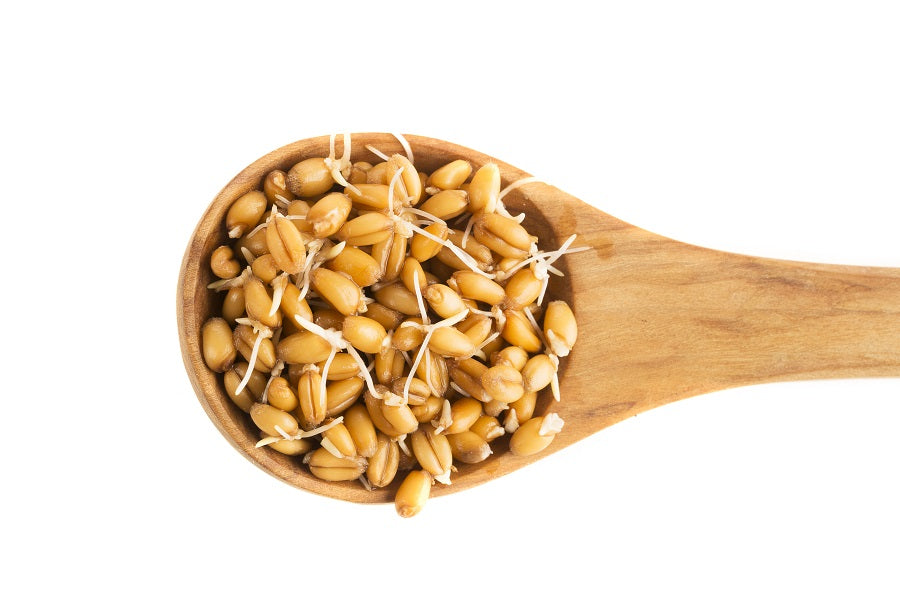Grains have earned a reputation for being unhealthy, fattening, and lacking nutritional value. This holds only for refined, bleached, grains that contain gluten, however. Gluten-free whole grains are relatively healthy, and sprouted ones are even better. If you sprout your grains, you can eat plenty of grains daily without compromising your health.
What are Sprouted Grains?
Whole grains are seeds that, like any other seeds, grow into plants when placed in the right temperature and moisture conditions. It is crucial that it is a whole grain, however, because all of the germ, endosperm, and the bran are required for the plants to grow out of the seed. The germ is the embryo, the endosperm contains the starches and proteins on which the embryo feeds to grow, and the bran provides some nutrition as well as protects the seed. When you wet the grains and leave them in a mild temperature, the plants will grow. You can either eat the sprouted seeds raw or sprinkle them on salads and baked dishes, or you can use a flour mill to grind them into flour with which you bake bread. The crucial step is to ensure that you stop the sprouting before the plants grow fully.
Superior Digestibility of Sprouted Grains
Sprouted grains are easier for your body to digest and are, thus, gentler on your stomach, your intestines, your pancreas, and your liver. An unsprouted whole grain contains various substances, like phytic acid and enzyme inhibitors, that inhibit its growth into a plant. When you sprout it, these substances are destroyed by enzymes created during the sprouting process. These enzymes also transform the starches in the endosperm to simpler molecules that the baby plant can digest more easily. The human body also digests these more easily, but only if you halt the sprouting process before the growing plant becomes a grass stalk, which our bodies cannot digest at all.
Superior Nutritiousness of Sprouted Grains
Sprouting increases the fibre, folate, amino acid, and vitamins A, B, C, and K content in whole grains, thereby increasing their nutritional value over that of the unsprouted seed. This should not be surprising, as the sprouted grain, or rather the baby plant, increases the nutritional content of the foods it eats.
Superior Alkalinity of Sprouted Grains
Sprouted grains are more alkaline than unsprouted ones, because these little plants have a lower starch content and higher protein, vitamin, and mineral content than whole grain seeds. Unless something specifically unhealthy is present, such as the acidic substances released when our bodies digest animal proteins, the alkalinity of nutritional foods is always higher than that of foods that contain mostly empty calories. In addition, the three chief alkaline minerals of calcium, magnesium, and potassium bind directly to the phytic acid in unsprouted grains and are then either destroyed or excreted immediately. When you eat sprouted grains, on the other hand, your body can absorb these alkaline minerals. Lastly, sprouted grains contain less gluten than sprouted ones. Gluten forms acid when your body processes it.
How to Sprout Grains
1. Put the grains into a bowl or jar. There must be enough space for them to double in size without crowding. If you want to sprout small seeds, some companies sell sprouting jars with screen tops that make it easier to rinse and drain them. Alternatively, make your own sprouting bowl by tying a sieve or any netting material over the top of the bowl with an elastic or rope. You want it to be tight enough so you can turn the bowl over to dump the water.
2. Cover the grains with room-temperature water and let them soak for eight hours. If your first batch of grains grow mouldy during the sprouting process, add half a teaspoon of ascorbic acid or grapefruit extract to this water. This is only necessary if you find that you have a mould problem.
3. After eight hours, dump the water and rinse the grains well. Turn the bowl over and shake it gently until all the water escapes. The grains do not want to lie in water once the first eight hours have passed, otherwise they will definitely become mouldy.
4. Rinse the grains every eight hours until they have doubled in size. For most grains, this will take no more than three days, but depending on the temperature in which they sprout, they may take longer. Normally, the longer you soak them at the beginning, the longer they take to sprout. Canadian researchers liked the result of sprouting wheat when they soaked it for 24 hours and sprouted them for seven days thereafter.
Which Grains to Sprout
A properly alkaline diet requires that you omit all or almost all gluten-containing grains.
Gluten-free grains include;
- amaranth,
- arborio rice,
- basmati rice,
- brown rice,
- buckwheat,
- millet,
- oats,
- quinoa,
- teff,
- and wild rice.
Corn and sorghum are also gluten-free, but higher in starch and lower in nutrients and thus not much less acidic than refined grains. Spelt contains gluten, but its nutritional content gives it the same pH as buckwheat, slightly below neutral (seven). If you want to bake with gluten, this is the only option, especially if you sprout it, in which case its pH is neutral or slightly above. Overall, the most alkaline whole grains even before sprouting are brown rice, buckwheat, millet, oats, quinoa, and teff.
The Gluten Problem
Gluten does not only form acids when your body processes it, but many people are also allergic to it without being aware of this fact. Gluten is a combination of grain proteins like glutamines and prolines, a category of proteins called prolamins. Unlike the proteins in gluten-free grains, prolamins have low nutritional value and perform no important functions in your body.
Moreover, around one per cent of people have a genetic predisposition to develop celiac disease when eating gluten, a disease that causes your small intestine to become inflamed. These people experience serious diarrhoea, bloating, stomach pain, inability to digest food, weight loss, and general symptoms like fatigue. Researchers also estimate that around 10 per cent of other people have non-celiac gluten sensitivity, a disorder that causes poor digestion, heartburn, stomach ache, diarrhoea, bloating, headaches, fatigue, and many other general symptoms.
Other diseases caused by gluten intolerance include Duhring's disease (blisters all over your skin), gluten ataxia (inability to coordinate muscle movements), numbness in hands and feet, joint pain, and many more. This is why it is far better to eat and sprout gluten-free grains.




























Leave a comment